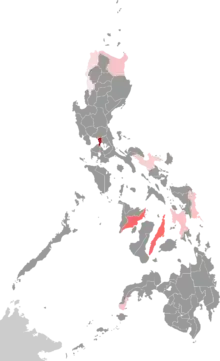Hokaglish
Hokaglish (or Philippine Hybrid Hokkien, /ˈhɒkəɡlɪʃ/), also known by locals as Sa-lam-tsam oe (mixed language, Tai-lo: sann-lām-tsham-uē, [sãlamt͡sʰamue]), is an oral contact language primarily resulting among three languages: (1) Philippine Hokkien Chinese, (2) Tagalog and (3) English.[1] (Other languages that have relative influence include Spanish, Cantonese and other local peripheral languages.)[2]
| Hokaglish | |
|---|---|
| Philippine Hybrid Hokkien | |
| salamtsam-oe or "EngChiLog" | |
| Native to | Philippines |
| Region | Manila (concentrated in Binondo) |
| Ethnicity | Chinese Filipinos |
Native speakers | (More than 100,000 cited 1945 – present) |
Hokkien mixed language
| |
| Not applicable, oral contact language | |
| Official status | |
Official language in | Not official, Minority language of the Philippines Binondo, Metro Manila (lingua franca) and abroad |
Recognised minority language in | |
| Language codes | |
| ISO 639-3 | None (mis) |
 Area where Hokaglish is spoken | |
Usage
Typically used by Filipino Chinese or Chinese Filipinos, Hokaglish is used by various corporations, academic institutions, restaurants, and religious institutions.[1] Some note that this is a result of having to maintain command of all three languages in the spheres of home, school and greater Philippine society. Although used by Chinese Filipinos in general, this form of code-switching is very popular with the younger generation (Tsinoys).[3]
Etymology
The term Hokaglish is a portmanteau or blend of Hokkien and Taglish, itself a blend of Tagalog and English. It was first recorded in 2016.[4]
Classification
Earlier thought to be a creole,[2] it may actually be a mixed language similar to Light Warlpiri or Gurindji Kriol. It is also considered a hybrid English or X-English, making it one of the Philippine Englishes.[5]
See also
- Light Warlpiri in Australia
- Gurindji Kriol
- Media Lengua
- Taglish in the Philippines
- Chavacano in the Philippines
- Singlish, similar phenomenon in Singapore
References
- Wong Gonzales, Wilkinson Daniel (May 2016). "Exploring trilingual code-switching: The case of 'Hokaglish' (PDF Download Available)". Retrieved 2016-10-24 – via ResearchGate.
- Wong Gonzales, Wilkinson Daniel (16 November 2016). The language ecology of post-colonial Manila and Hokaglish – via ResearchGate.
- Zulueta, Johana. "I "Speak Chinese" but..." Code switching and Identity Construction in Chinese Filipino Youth". www.revistas.usp.br. Retrieved 2017-02-23.
- Lambert, James. 2018. A multitude of ‘lishes’: The nomenclature of hybridity. English World-wide, 39(1): 22. DOI: 10.1075/eww.38.3.04lam
- Wong Gonzales, Wilkinson Daniel. "Philippine Englishes". Asian Englishes. 19: 79–95. doi:10.1080/13488678.2016.1274574.